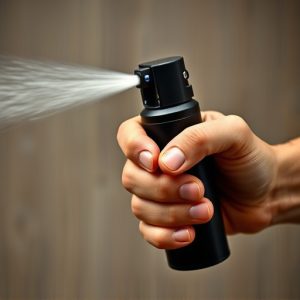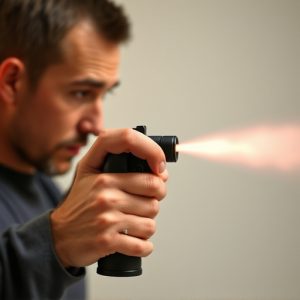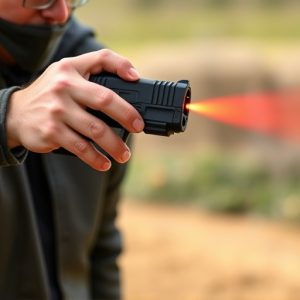Concealed Pepper Spray Carrying Techniques: Legal & Safe Deployment for Law Enforcement
Riot control agents like pepper spray are less-lethal weapons used globally by law enforcement to di…….
Riot control agents like pepper spray are less-lethal weapons used globally by law enforcement to disrupt and disperse crowds while minimizing harm, with strict regulations governing their possession, use, and distribution. Specialized holsters and pouches enable officers to carry concealed pepper spray techniques for quick deployment during chaotic scenarios, enhancing safety and control. Training programs simulate real-world chaos, teaching precise deployment, risk anticipation, and de-escalation skills, ensuring effective and safe riot control agent use in civil disturbances.
Riot control agents, particularly pepper spray, have become indispensable tools in law enforcement, offering a crucial means of de-escalation and crowd management. This article explores the multifaceted aspect of riot control agent usage, focusing on concealed carrying techniques. We delve into the types and effects of these agents, dissect legal frameworks governing their use, especially around concealed carrying, and highlight essential training and safety measures for responsible deployment. Understanding these elements is key to optimizing public safety during civil disturbances.
- Understanding Riot Control Agents: Types and Their Effects
- Legal Frameworks: Regulations on Pepper Spray for Law Enforcement
- Concealed Carrying Techniques: Strategies for Effective Deployment
- Training and Safety Measures: Preparing Officers for Responsible Use
Understanding Riot Control Agents: Types and Their Effects
Riot control agents, also known as less-lethal weapons, are chemical compounds designed to disrupt and disperse crowds while minimizing harm to both law enforcement officers and civil entities. These agents operate by causing discomfort or incapacitation through a variety of mechanisms, including irritation of the eyes, respiratory system, and skin. Understanding the types and effects of these agents is crucial for effective deployment and officer safety during high-stakes situations.
Concealed pepper spray carrying techniques play a significant role in modern riot control tactics. Pepper spray, one of the most common types, works by causing temporary blindness, coughing, and difficulty breathing. Officers are trained to employ these agents tactically, often using specialized holsters or concealed pouches that allow for swift access during chaotic scenarios. Mastering concealed carrying techniques ensures law enforcement can respond quickly, maintaining the upper hand while mitigating risks associated with crowd control.
Legal Frameworks: Regulations on Pepper Spray for Law Enforcement
Law enforcement agencies across the globe have long relied on pepper spray as a crucial riot control agent, but its use is tightly regulated to ensure public safety and responsible deployment. The legal frameworks surrounding pepper spray vary significantly from one country to another, with many regions implementing stringent rules on its possession, use, and distribution. In many jurisdictions, law enforcement officers are required to undergo specialized training before being authorized to carry pepper spray, focusing on concealed carrying techniques to minimize the risk of unintended activation or misuse.
These regulations often dictate specific types of pepper spray that can be used, their concentrations, and the circumstances under which they can be deployed legally. For instance, some regions limit the use of pepper spray to self-defense or crowd control scenarios, while others have broader exceptions for law enforcement operations. The legal frameworks also govern how much pepper spray officers can carry on duty and where it can be stored within their vehicles, with an emphasis on securing the agent from unauthorized access or accidental discharge. Concealed carrying techniques play a vital role in these regulations, ensuring that officers can manage the spray effectively while maintaining professional conduct during high-pressure situations.
Concealed Carrying Techniques: Strategies for Effective Deployment
In the realm of riot control, law enforcement officers often rely on concealed carrying techniques to effectively manage high-risk situations. One key tool in their arsenal is concealed pepper spray, which requires strategic deployment for optimal effectiveness. Officers are trained to carry this agent discreetly, ensuring it’s readily accessible yet hidden from public view. Techniques involve utilizing specialized holsters and pouches designed for stealthy storage, allowing quick retrieval during chaotic events.
These concealed pepper spray carrying techniques focus on balance and comfort, enabling officers to maintain mobility while ensuring the agent is within easy reach. Proper training includes learning to deploy the spray under stress, aiming at specific targets, and understanding the various types of pepper spray formulations for different tactical needs. This strategic approach not only enhances officer safety but also aids in managing crowd control efficiently.
Training and Safety Measures: Preparing Officers for Responsible Use
In the realm of law enforcement, preparing officers for the responsible use of riot control agents is paramount to ensure public safety and maintain control during tumultuous situations. Training programs often include extensive simulations and scenarios that mimic real-world chaos, allowing officers to learn concealed pepper spray carrying techniques effectively. These exercises not only hone their skill in deploying the agent precisely but also teach them to anticipate potential risks and de-escalate tense environments.
Safety measures are a cornerstone of this training, emphasizing the importance of minimizing collateral damage and mitigating health risks for both officers and bystanders. Officers learn to check wind direction, wear appropriate protective gear, and understand the range and effects of riot control agents. By mastering these techniques and adhering to strict protocols, law enforcement can navigate challenging scenarios with enhanced confidence and control, making them better equipped to handle civil disturbances responsibly.
The effective use of riot control agents, particularly concealed pepper spray carrying techniques, requires a balanced approach. While these tools can aid law enforcement in managing disturbances, proper training and adherence to legal frameworks are paramount. By understanding the types and effects of these agents, officers can deploy them responsibly, ensuring public safety without causing undue harm. Embracing best practices for concealed carrying techniques, along with comprehensive training, is essential to maintain order while upholding constitutional rights.


